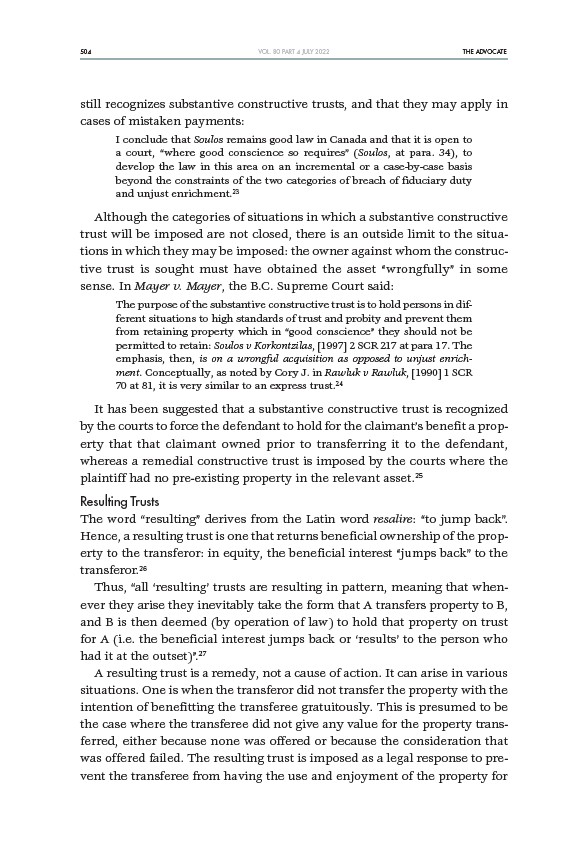
504 THE ADVOCATE
VOL. 80 PART 4 JULY 2022
still recognizes substantive constructive trusts, and that they may apply in
cases of mistaken payments:
I conclude that Soulos remains good law in Canada and that it is open to
a court, “where good conscience so requires” (Soulos, at para. 34), to
develop the law in this area on an incremental or a case-by-case basis
beyond the constraints of the two categories of breach of fiduciary duty
and unjust enrichment.23
Although the categories of situations in which a substantive constructive
trust will be imposed are not closed, there is an outside limit to the situations
in which they may be imposed: the owner against whom the constructive
trust is sought must have obtained the asset “wrongfully” in some
sense. In Mayer v. Mayer, the B.C. Supreme Court said:
The purpose of the substantive constructive trust is to hold persons in different
situations to high standards of trust and probity and prevent them
from retaining property which in “good conscience” they should not be
permitted to retain: Soulos v Korkontzilas, 1997 2 SCR 217 at para 17. The
emphasis, then, is on a wrongful acquisition as opposed to unjust enrichment.
Conceptually, as noted by Cory J. in Rawluk v Rawluk, 1990 1 SCR
70 at 81, it is very similar to an express trust.24
It has been suggested that a substantive constructive trust is recognized
by the courts to force the defendant to hold for the claimant’s benefit a property
that that claimant owned prior to transferring it to the defendant,
whereas a remedial constructive trust is imposed by the courts where the
plaintiff had no pre-existing property in the relevant asset.25
Resulting Trusts
The word “resulting” derives from the Latin word resalire: “to jump back”.
Hence, a resulting trust is one that returns beneficial ownership of the property
to the transferor: in equity, the beneficial interest “jumps back” to the
transferor.26
Thus, “all ‘resulting’ trusts are resulting in pattern, meaning that whenever
they arise they inevitably take the form that A transfers property to B,
and B is then deemed (by operation of law) to hold that property on trust
for A (i.e. the beneficial interest jumps back or ‘results’ to the person who
had it at the outset)”.27
A resulting trust is a remedy, not a cause of action. It can arise in various
situations. One is when the transferor did not transfer the property with the
intention of benefitting the transferee gratuitously. This is presumed to be
the case where the transferee did not give any value for the property transferred,
either because none was offered or because the consideration that
was offered failed. The resulting trust is imposed as a legal response to prevent
the transferee from having the use and enjoyment of the property for